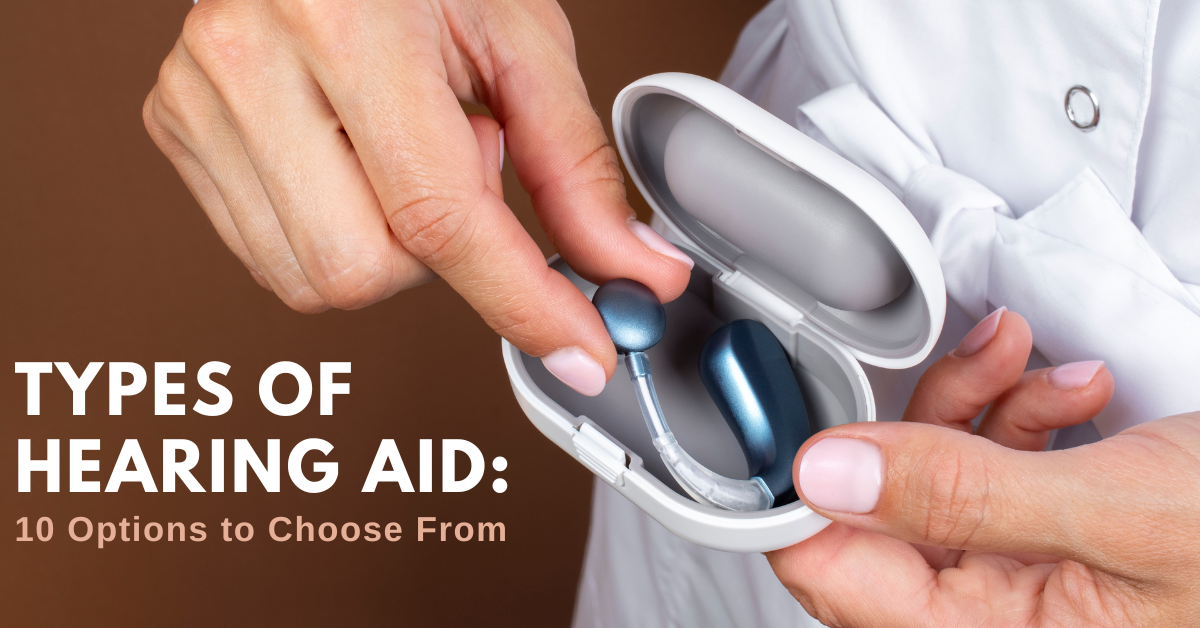Different types of hearing aids have risen in demand due to the astonishing number of people suffering from hearing loss. According to the latest report from WHO, around 430 million people, out of which 34 million are children, require medical support and hearing aids to address hearing loss. But will one solution fit every individual’s needs? That is quite unlikely.
Finding the perfect hearing aid depends upon several factors. The prime ones include hearing loss severity, shape/size of ears, and personal preferences. All these factors decide which type of hearing will suit you the best.
Primarily, there are ten types of hearing aid styles. Let us explore them in detail.
1. Behind the ear (BTE) devices
The first in the list of prime types of hearing aids is “behind the ear” (BTE) devices. BTE devices refer to hearing aid solutions that fit at the visible part of the ear outside your head (usually called the auricle). These devices comprise a case, a dome tip/earmold, and a tube. The tube connects the case with the dome tip or the earmold. The case houses a battery, controls, microphone(s), and loudspeaker/receiver.
Furthermore, BTE devices come in different sizes, ranging from small to larger, ultra-powerful devices. Although you can use these devices for any hearing loss severity, we recommend consulting a reputed hearing aid clinic for the right solution.
2. CROS/BiCROS devices
The second in the list of prime types of hearing aids is CROS/BiCROS devices. Contralateral Routing of Signal (CROS) and Bilateral microphones with Contralateral Routing of Signal (BiCROS) devices refer to solutions that transfer auditory information from one part of the head to another. Hearing aid clinics recommend CROS devices to people with hearing issues on one side and perfect hearing on the other side. BiCROS devices are effective for those having hearing loss on one side and moderate hearing on the other side.
Both these solutions come with a device and a microphone. Hearing aid clinics put the device on the side where you can listen normally and a microphone on the side with good or moderate hearing. The device transmits the information to the microphone. This transmission lets you hear clearly and localize sound from the affected side.
3. In the canal (ITC)
The third in the list of prime types of hearing aids is “in the canal” (ITC) solutions. These solutions fit deeply into ear canals compared to ITE devices. However, earwax can often clog the device’s speaker, and this can lead to hearing issues. Due to their small sizes, they comprise smaller batteries and are less visible. Despite its small size, ITC may be difficult to adjust and handle. This type of hearing aid helps people with less to moderate hearing loss.
4. In the ear (ITE)
The fourth in the list of prime types of hearing aids is “in the ear (ITE)” devices. ITE devices come in two main categories – full shell and half shell. The full shell ITE fits entirely in the outer ear’s bowl-shaped area. On the other hand, the half shell only covers the lower part of the bowl-shaped area. These solutions comprise larger batteries and directional microphones. Clinics recommend ITE devices for people having moderate to severe hearing issues.
5. Receiver in the ear (RITE)
The fifth in the list of prime types of hearing aids is “receiver in the ear (RITE)” devices. These hearing aid solutions are similar to “behind the ear” devices. However, unlike BTE, the speaker/receiver of this device is fitted in the ear canal instead of a shell. A soft tube called a dome connects the device to the ear. The dome does not seal the ear canal and lets the sound naturally flow in and out of the ear. These devices can help improve mild to severe hearing loss.
6. Receiver in the canal (RIC)
The last in the list of prime types of hearing aids is “receiver in the canal (RIC)” devices. RITE has a similar style to BTE. These devices have a directional microphone, speaker/receiver, and a wire. The wire connects the microphone to the speaker/receiver that fits in the ear canal. Furthermore, it comes with manual controls that offer greater control to the users.
Additional Types of Hearing Aids
Some additional types of hearing aids include:
- Bone-anchored (BAHA) devices
- Completely in the canal (or Mini CIC) devices
- Invisible devices
- Open fit devices
Conclusion
So those were the prime types of hearing aids at a glance. To select the right hearing aid for you or your loved ones, you must consult with an experienced hearing aid clinic. For more details and information on hearing aids, do not forget to follow our blog.

